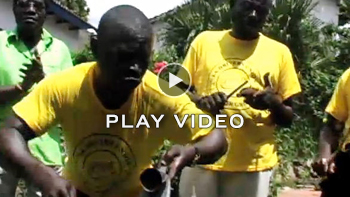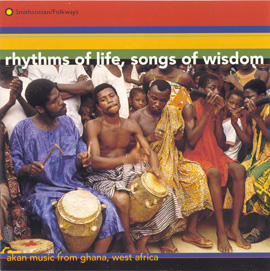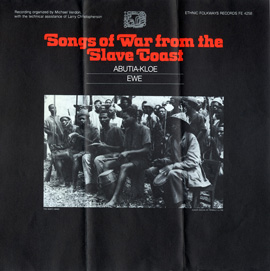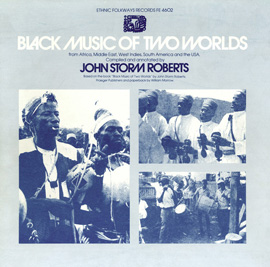Summary
This lesson is intended to develop knowledge regarding Ghanaian music. Students will experience the musical cultures of Ghana through listening, movement, game play, and percussion performance. Lesson segments are designed to stand alone, but sequential presentation may yield greater success as the experiences progress toward more rigorous performance requirements for both the students and instructor.
Suggested Grade Levels: 6-8
Country: Ghana
Region: West Africa
Culture Group: Akan, Dagomba, Ewe, Ga
Genre: World
Instruments: Voice, Body Percussion, Gankogui, Axatse, Kidi, Kagan (or substitutes as suggested)
Language: N/A
Co-Curricular Areas: Geography, Social Studies
National Standards: 1, 2, 5, 6, 7, 9
Prerequisites: Experience playing and reading music in 6/8 time
Objectives:
- Listening to and viewing musical expressions
- Identifying cultural and musical traits of Ghanaian music
- Understanding the role of a common fundamental bell pattern
- Identifying aurally presented rhythms using written notation
- Playing a Ghanaian children’s game
- Performing traditional/folkloric polyrhythmic structures
Material:
- Fontomfrom, from Rhythms of Life, Songs of Wisdom: Akan Music from Ghana
- Brass Band: Yesu ye medze/Nyame ye osahen, from Rhythms of Life, Songs of Wisdom: Akan Music from Ghana
- Rhythms of Life, Songs of Wisdom, liner notes
- Gondze Praise Music (2), from Music of the Dagomba from Ghana
- Music of the Dagomba from Ghana, liner notes
- Funeral Dirge - The Warrior's House Has Become Empty, from Ewe Music of Ghana
- Kpegisu, from Ewe Music of Ghana
- Gadzo - Kayiboe - The Child Is Not Matured - The Child is Underage, from Ewe Music of Ghana
- Ewe Music of Ghana, liner notes
- La Drivers Union Por Por Group Perform “M.V. Labadi” video
Lesson Segments:
- Survey of Ghanaian Musical Expressions (National Standards 1, 6, 7, 9)
- Exploring a Common Bell Pattern (National Standards 2, 5, 6, 9)
- Ampe Jumping and Clapping Game (National Standards 2, 8, 9)
- Performing Non-Pitched Percussion for “Gadzo” (National Standards 2, 9)
Lesson Segment 1: Survey of Ghanaian Musical Expressions

“Fontomfrom”
from Rhythms of Life, Songs of Wisdom: Akan Music from Ghana (1996) | SFW40463
“Brass Band: Yesu ye medze/Nyame ye osahen”
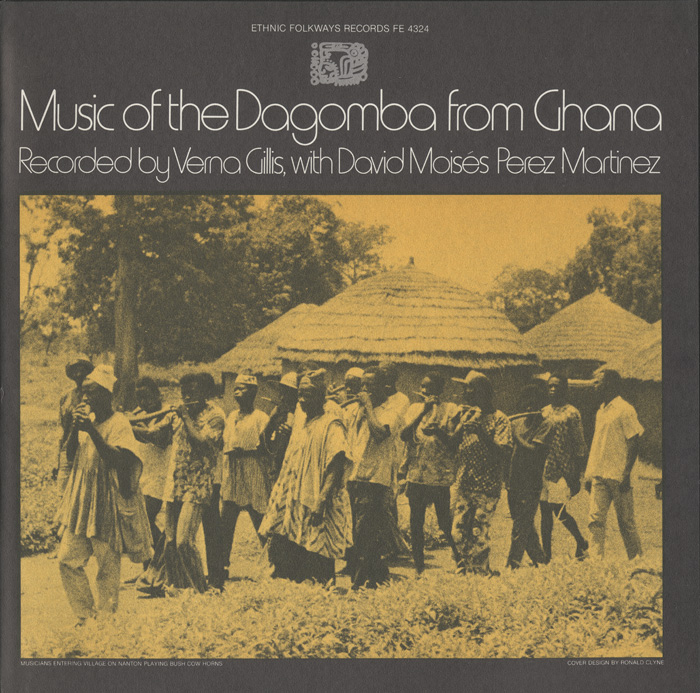
“Gondze Praise Music (2)”
from Music of the Dagomba from Ghana (1978) | FW04324
Procedure:
- Listen to the track Fontomfrom.
- Ask students to listen and try to identify where this music might come from
- Guide the students toward identifying the source as Ghana, West Africa
- Display the map on page 2 from the liner notes to Rhythms of Life, Songs of Wisdom and read from the first four lines of text on page 3.
- Inform the students that each of the over 100 ethnic groups have their own unique musical expressions, as well as some that are shared among them
- Fontomfrom comes from the Akan people in the Central Region of Ghana
- Display page 16 from the same liner notes and summarize the notes on the ensemble from page 12
- Listen to the first 30 seconds from the track Gondze Praise Music (2).
- Identify the ethnic group as the Dagomba people from northern Ghana. Prompt students to listen for the following:
- How many singers? (2)
- What gender are the singers? (male)
- Are the singers adults or children? (adults)
- What kinds of instruments do you hear? (rattle, 2 single string fiddles called “gonji” or “gondze”)
- Listen again to the first 30 seconds from Gondze Praise Music (2) and prompt the students to listen for the following:
- Focus on the fiddles
- Are the phrases long or short? (short)
- Do the phrases repeat, or do they change throughout? (repeat)
- Do any of the notes sound especially unusual? (yes, the fourth note of the repeated phrase)
- Listen a final time to first 30 seconds from Gondze Praise Music (2).
- Instruct students to sing the repeated fiddle part on a neutral syllable while keeping a steady beat with lap pats
- Listen to the track Brass Band: Yesu ye medze/Nyame ye osahen.
- Invite students to stand and move in any way that they choose while listening for the following:
- What instruments are playing that you might hear in school?
- Are the instruments being played as they would be in school?
- Does the dynamic level change or stay the same throughout?
- What dynamic level would you use to describe this music?
- Is the mood of this music happy or sad?
- Summarize (or read in entirety) the Brass Band information from page 14 of the liner notes for Rhythms of Life, Songs of Wisdom.
Extensions:
- Listen multiple times to the entire first song from the track Gondze Praise Music (2).
- Focus student listening on describing the large-scale form of the music as described on page three of the liner notes from Music of the Dagomba from Ghana
- Play video of M. V. Labadi.
- Ask students to identify the instruments being used
- Read summary of the Por Por music as written below the video display
- Facilitate a group composition using combinations of musical instruments and everyday items in the music classroom
Assessment:
Students will display a more sophisticated perspective on the variety of African music in general and Ghana in particular. Students will be able to identify different instrumental and vocal constructions, and provide general information regarding the possible roles of music in the lives of Ghanaian people.
Lesson Segment 2. Exploring a Common Bell Pattern
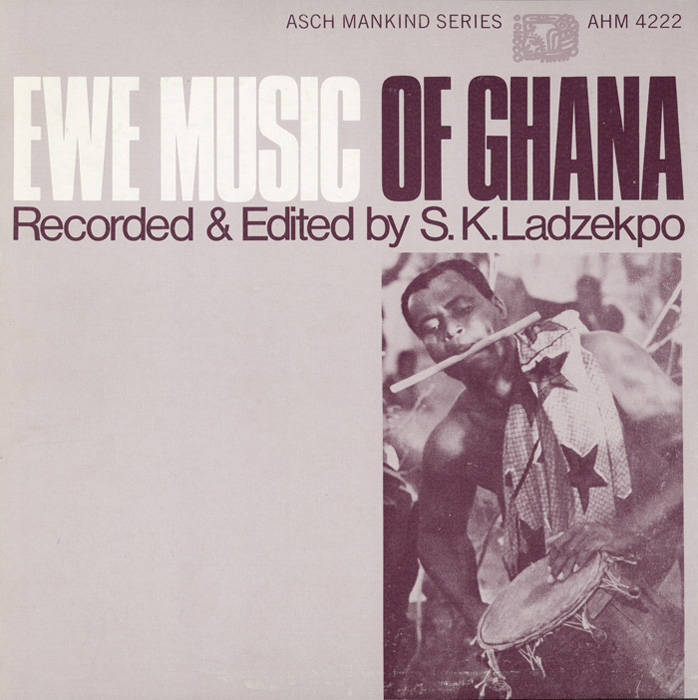
“Funeral Dirge - The Warrior's House Has Become Empty”
from Ewe Music of Ghana (1969) | FW04222
“Kpegisu”
“Gadzo - Kayiboe - The Child Is Not Matured - The Child is Underage”
Procedure:
- Play track of Funeral Dirge - The Warrior's House Has Become Empty.
- Instruct students to identify the instruments played to accompany the singer
- Identify the instrument as a gankogui, or double bell
- Identify the roll of the primary bell.
- There are primary and secondary bells in many Ghanaian musical expressions
- The primary bell provides the timeline, serving as “conductor” for the other musicians and dancers
- The secondary bell(s) provide(s) support for the primary bell
- The primary bell is constant: it does not improvise
- The bell pattern heard in Funeral Dirge is prevalent in much of the music of the Ewe people in south-eastern Ghana
- This rhythm is sometimes called the “6/8” or “12/8” bell pattern
- This rhythm can also be found in the music of some Caribbean cultures, and is played on the drum set in many “Latin jazz” performances
- Replay track of Funeral Dirge.
- Ask students to perform the gankogui pattern using one of the following pairs of body percussion sounds:
- Leg pats (low bell) - hand claps (high bell)
- Two fingers against palm (low bell) - two fingers against chest (high bell)
- Hand pats on stomach (low bell) - hand pats on chest (high bell)
- Inform students that they will now hear two bells and play track of Kpegisu.
- Ask students to stand and step in place to the steady beat played by the secondary (low) bell
- Clap along to the primary (high) bell pattern and encourage students to join in when they are comfortable
- Play track of Gadzo - Kayiboe - The Child Is Not Matured - The Child is Underage.
- Ask students to listen for the same bell pattern from the previous two pieces
- Lead the students in showing the underlying steady beat using leg pats
- Lead the students in showing the first beat of the bell pattern with hand claps
- Display the notation for the gankogui pattern from Funeral Dirge, as well as two or three other high-low patterns in 6/8.
- Replay track of Funeral Dirge
- Ask students to identify the correct pattern from those displayed
Gankogui Pattern for Funeral Dirge (and Gadzo)
Bell Patterns for Kpegisu
Extensions:
Have students listen to additional music from Ghana to identify similar or different bell patterns.
Assessment:
Students should be able to identify aspects of the role or function of the bell as conductor and time-keeper in some Ghanaian music. Students should be able to perform the gankogui pattern smoothly and at a consistent tempo.
Lesson Segment 3. Ampe Jumping and Clapping Game
Procedure:
- Play track of Kpegisu. (Multiple listenings may be necessary to complete)
- Lead students in leg pats with the steady beat of the low bell (see Lesson 2 above for transcription)
- Lead students in clapping on every first and fourth beats of the low bell
- Lead students in clapping on the first and fourth beats while jumping straight up on the second and third beats
- While performing these movements, lead students in kicking quickly with the right foot between the two claps
- Repeat and alternate, kicking with left foot
- Identify the game to be learned as Ampe (A sounds as in archery, e sounds as in peg).
- Ampe is a very popular game in Ghana, played by children both at school and elsewhere
- In Ghana, the game is not accompanied by instruments
- Form students into a circle. The game is played as follows:
- One student will be designated as the leader and will come to the center
- The leader chooses a challenger to join him or her in the center
- The students in the center of the circle will perform the movement from section a (part iv above)
- This begins with a pickup clap as seen in the transcription
- Each student inside the circle will choose to kick with either the right or left foot
- If both students kick with their right feet, then the leader stays in the middle and chooses a new student to play agains
- If one student chooses the left foot and the other student chooses the right, then the challenger becomes the leader and chooses a new challenger
- Repeat game until all students have participated
Ampe
Assessment:
Students should be able to perform the movements for Ampe (clap, jump, and kick) in simultaneity with other students, with or without accompanying music.
Lesson Segment 4. Performing Non-Pitched Percussion from “Gadzo”
Procedure:
- Listen to the track of Gadzo. Ask students to listen for the following:
- What instruments are used? (drum, rattle, bell)
- How many singers are there? One or many? (many)
- Is the tempo fast or slow? (fast)
- Read the brief description of Gadzo from page five in the liner notes.
-
Play the gankogui part at a moderate tempo (if a gankogui is not available, substitute agogo bells or tick-tock blocks).
- Instruct students to perform leg pats with the low bell
- Instruct students to add hand claps with the high bell
- Distribute bells to students and lead them in performing the pattern
- Students without instruments may continue using body percussion
- Play the axatse part at a moderate tempo (if an axatse is not available, substitute a gourd rattle, shekere, or maraca).
- Instruct students to place their right hand, palm down, on their right leg (this is the hand that will eventually hold the axatse)
- Instruct students to hold their left hand, palm down, above their right hand
- Play the axatse part again, asking students to mimic the motion using their empty right hand
- It may be helpful to emphasize the single note on the first beat by turning the left hand over and moving it to the side
- Distribute rattles to students and lead them in performing the pattern
- Students without instruments may continue using body percussion
- Listen to the track of Funeral Dirge.
- Lead students in playing the axatse part using body percussion only
- This will establish the relationship of the axatse to the gankogui
- Emphasize the simultaneity of the low bell note of the gankogui and the “long” note of the axatse
- Lead students in playing the gankogui part using body percussion.
- When the students’ performance solidifies, begin playing the first note (only) of the axatse part.
- After students acclimate, perform the entire axatse part
- Play the gankogui part.
- Instruct students to play only the long note of the axatse part using body percussion
- Encourage students to add the entire axatse part when they are comfortable
- Distribute bells and rattles.
- Lead students with bells in playing the gankogui part
- Using a visual or aural cue, lead students with rattles in playing the axatse part beginning on the third cycle of the gankgui
- Instruct students to exchange instruments and perform again
- Play the kidi part at a moderate tempo (if a kidi is not available, substitute any drum that is playable with two sticks).
- Muted tones are achieved by leaving the stick on the drum head after striking
- At slower tempos, this can be emphasized by pressing the stick down into the head
- Lead students in performing the rhythm of the kidi part using body percussion
- Distribute drums and sticks and lead students in performing the kidi part
- Using the same procedure as with the axatse:
- Establish the relationship of the kidi part to the gankogui using the track of Funeral Dirge
- Play the kidi part with the gankogui part
- Play the kidi, gankogui, and axatse parts together
- Using the same procedure as with the kidi, integrate the kagan part into the rhythmic complex (if no kagan is available, substitute any drum that is playable with sticks).
- The kagan part should be played with drums that are pitched higher than those being used for the kidi part
- Allow each student to perform every part with the group.
Non-Pitched Percussion Parts for Gadzo
D = played down against leg
U = played up against palm of hand
+ = muted stroke
Extensions:
- If traditional instruments are not being used, display images of them for students to see.
- Images can be found by entering the names of the instruments into popular search engines
- Note that kagan is also commonly spelled “kaganu”
- Facilitate the creation of a new dance-drama using the parts for Gadzo.
- Instruct students to discuss a major event in their school or neighborhood.
- Brain storm possible dance movements or gestures that could represent the event.
- Restriction to eight or sixteen beats is advisable
- Props could be used
- Choose one or more dance movements and instruct students to compose a rhythm that could be used to accompany the movement.
- Choose one student to play the new, “master drum” part on a conga or other medium or large sized hand drum with the Gadzo percussion parts to accompany the dance-drama.
Assessment:
Students should be able to successfully play one or more of the non-pitched percussion parts, with or without the support of additional musicians or instruments. Are they playing the proper rhythms? Are they successfully connecting other parts to the gankogui?


